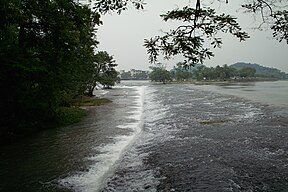Lingqu
25°35′56″N 110°41′23″E / 25.59889°N 110.68972°E
| Lingqu | |
|---|---|
 | |
 | |
| Location | Xing'an County, Guangxi |
| Country | China |
| Specifications | |
| Length | 36.4 km (22.6 miles) |
The Lingqu (simplified Chinese: 灵渠; traditional Chinese: 靈渠; pinyin: Líng Qú) is a canal in Xing'an County, near Guilin, in the northwestern corner of Guangxi, China.
It connects the Xiang River (which flows north into the Yangtze) with the Li River (which flows south into the Gui River and Xijiang), and thus is part of a historical waterway between the Yangtze and the Pearl River Delta. It was the first canal in the world to connect two river valleys and enabled boats to travel 2,000 kilometres (1,200 mi) inland from Beijing to Pearl River Delta.[1] It is also one of the most well-preserved such projects in the world.[2]
The canal is 36.4 kilometres (22.6 mi) long.[3]
History
[edit]In 214 BC, Qin Shi Huang, the First Emperor of the Qin dynasty (221–206 BC), ordered the construction of a canal connecting the Xiang and the Li rivers, in order to attack the Baiyue tribes in the south. The architect who designed the canal was Shi Lu (Chinese: 史祿). It is the oldest contour canal in the world,[1] receiving its water from the Xiang. It was fitted with thirty-seven flash locks by 825 AD. There is a clear description of pound locks in the twelfth century, which were probably installed one or two centuries before.[4] The canal also aided water conservation by diverting up to a third of the flow of the Xiang to the Li.[3]
The canal has been placed on the UNESCO World Heritage Sites tentative list.[3]
See also
[edit]References
[edit]Citations
[edit]- ^ a b The first contour transport canal (PDF), UNESCO Courier, Oct 1988
- ^ Chen, Anze; Ng, Young; Zhang, Erkuang; Tian, Mingzhong, eds. (2020), "Lingqu Canal", Dictionary of Geotourism, Singapore: Springer, pp. 349–350, doi:10.1007/978-981-13-2538-0_1406, ISBN 978-981-13-2538-0, retrieved 2023-09-27
- ^ a b c "Lingqu Canal". UNESCO World Heritage Centre.
- ^ Ronan, Colin A. (1995), The Shorter Science and Civilisation in China, vol. 5, Cambridge University Press, pp. 213ff, ISBN 9780521467735, retrieved 23 May 2012
Bibliography
[edit]- Day, Lance and McNeil, Ian . (1996). Biographical Dictionary of the History of Technology. New York: Routledge. ISBN 0-415-06042-7.
| Yangtze system | |
|---|---|
| Yellow system | |
| Pearl system | |
| Heilongjiang system | |
| Huai system | |
| Hai system | |
| Liao system |
|
| Other major rivers |
|
| Major canals | |
| Government agencies | |||||||
|---|---|---|---|---|---|---|---|
| Road | |||||||
| Rail | |||||||
| Water |
| ||||||
| Aviation |
| ||||||
| Space | |||||||
| Other topics | |||||||
Text is available under the CC BY-SA 4.0 license; additional terms may apply.
Images, videos and audio are available under their respective licenses.
